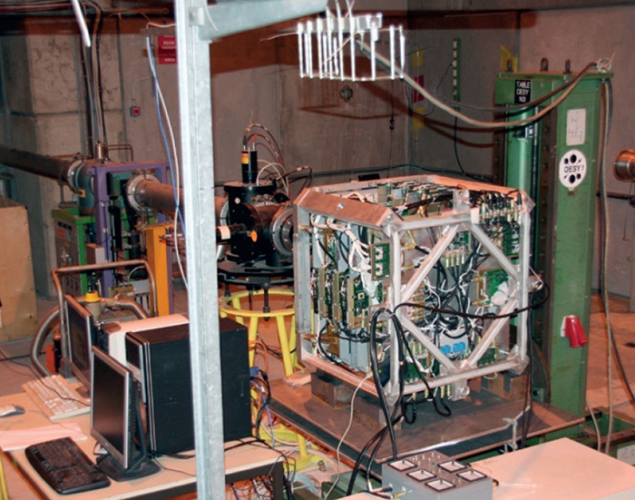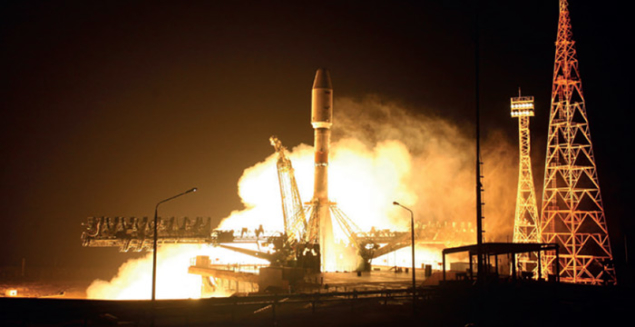
Image credit: JINR.
On 13 January, less than three weeks after being launched into space, the NUCLEON satellite experiment was switched on to collect its first cosmic-ray events. Orbiting the Earth on board the RESURS-P No.2 satellite, NUCLEON has been designed to investigate directly the energy spectrum of cosmic-ray nuclei and their chemical composition from 100 GeV to 1000 TeV (1011–1015 eV), as well as the cosmic-ray electron spectrum from 20 GeV to 3 TeV. It is well known that the region of the “knee” – 1014–1016 eV – is crucial for understanding the origin of cosmic rays, as well as their acceleration and propagation in the Galaxy.
NUCLEON has been produced by a collaboration between the Skobeltsyn Institute of Nuclear Physics of Moscow State University (SINP MSU) as the main partner, together with the Joint Institute for Nuclear Research (JINR) and other Russian scientific and industrial centres. It consists of silicon and scintillator detectors, a carbon target, a tungsten γ-converter and a small electromagnet calorimeter.

The charge-detection system, which consists of four thin detector layers of 1.5 × 1.5 cm silicon pads, is located in front of the carbon target. It is designed for precision measurement of the charge of the primary-particle charge.
A new technique, based on the generalized kinematical method developed for emulsions, is used to measure the cosmic-ray energy. Avoiding the use of heavy absorbers, the Kinematic Lightweight Energy Meter (KLEM) technique gives an energy resolution of 70% or better, according to simulations. Placed just behind the target, this energy-measurement system consists of silicon microstrip layers with tungsten layers to convert secondary γ-rays to electron–positron pairs. This significantly increases the number of secondary particles and therefore improves the accuracy of the energy determination for a primary particle.
The small electromagnet calorimeter (six tungsten/silicon microstrip layers 180 × 180 mm weighing about 60 kg, owing to satellite limitations) has a thickness of 12 radiation lengths, and will measure the primary cosmic-ray energy for some of the events. The effective geometric factor is more than 0.2 m2sr for the full detector and close to 0.1 m2sr for the calorimeter. The NUCLEON device must allow separation of the electromagnetic and hadronic cosmic-ray components at a rejection level of better than 1 in 103 for the events in the calorimeter aperture.

Image credit: Roscosmos.
The design, production and tests of the trigger system were JINR’s responsibility. The system consists of six multistrip scintillator layers to select useful events by measuring the charged-particle multiplicity crossing the trigger planes. The two-level trigger systems have a duplicated structure for reliability, and will provide more than 108 events with energy above 1011 eV during the planned five years of data taking.
The NUCLEON prototypes were tested many times at CERN’s Super Proton Synchrotron (SPS) with high-energy electron, hadron and heavy-ion beams. The last test at CERN, which took place in 2013 at the H2 heavy-ion beam, was dedicated to testing NUCLEON’s charge-measurement system. The results showed that it provides a charge resolution better than 0.3 charge units in the region up to atomic number Z = 30 (figure 2). The Z < 5 beam particles were suppressed by the NUCLEON trigger system.
In 2013, NUCLEON was installed on the RESURS-P No. 2 satellite platform for combined tests at the Samara-PROGRESS space-qualification workshop, some 1000 km southeast of Moscow. The complex NUCLEON tests were continued in 2014 at the Baikonur spaceport, in conjunction with the satellite and the Soyuz-2.1b rocket, before the successful launch on 26 December. The satellite is now in a Sun-synchronous orbit with inclination 97.276° and a middle altitude of 475 km. The total weight of the NUCLEON apparatus is 375 kg, with a power consumption of 175 W.
The flight tests of the NUCLEON detector were continued during January and February, and the NUCLEON team hopes to present the preliminary results at the summer conferences this year. The next step after this experiment will be the High-Energy cosmic-Ray Observatory (HERO) to study high-energy primary cosmic-ray radiation from space. The first HERO prototype is to be tested at the SPS in autumn.





